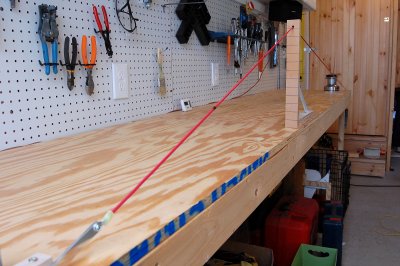There's been a little, somewhat critical, discussion in the "Rode Courtesy" thread about anchoring on short scope, which I interpret to mean a scope of less than 3:1--the ratio of the amount of rode veered out to the depth of the water, as it is sometimes defined. Some might argue short scope would be anything less than 5:1; etc., who knows? But first, what depth of water do we mean? The depth where the anchor was dropped or the depth of the water under the boat as it lays to the anchor? Considering that the depth of water under the boat is not a constant, at least not in the ocean even if moored by bow and stern anchors, due to tidal flows, scope is something that varies while anchored if the latter definition of "depth" is applied, which is the prevailing view, of course.
So, that brings me to the question of what is "short scope" when anchored on a steeply-sloping bottom, as it often is the situation when anchoring in the PNW. I cite the Harmony Islands as one example.There, an anchor might be dropped in 90 ft, whereupon the boat is backed toward shore for making a stern tie. Hardly 150 ft (maybe less) of rode MIGHT be veered before the vessel finds itself in maybe 25 ft at mid-tide on the spring-tide series. Now what? Reset in, say, 180 ft of depth to gain maybe a few more feet of rode veered out, but which in terms of scope little would have changed? It gets more ridiculous much beyond that. When the tide floods, the boat may rise another 8-10 feet. This could be in the middle of the night. So what might arguably have been effectively 6:1(?) (150'/25') scope referencing to the depth under the boat when first anchored and stern-tied, laying to its anchor, becomes maybe 4:1 (150/35) a few hours later. And there might be other boats nearby which serves to limit anchoring options. Would anybody consider the anchored vessel as described being on short scope?
So, that brings me to the question of what is "short scope" when anchored on a steeply-sloping bottom, as it often is the situation when anchoring in the PNW. I cite the Harmony Islands as one example.There, an anchor might be dropped in 90 ft, whereupon the boat is backed toward shore for making a stern tie. Hardly 150 ft (maybe less) of rode MIGHT be veered before the vessel finds itself in maybe 25 ft at mid-tide on the spring-tide series. Now what? Reset in, say, 180 ft of depth to gain maybe a few more feet of rode veered out, but which in terms of scope little would have changed? It gets more ridiculous much beyond that. When the tide floods, the boat may rise another 8-10 feet. This could be in the middle of the night. So what might arguably have been effectively 6:1(?) (150'/25') scope referencing to the depth under the boat when first anchored and stern-tied, laying to its anchor, becomes maybe 4:1 (150/35) a few hours later. And there might be other boats nearby which serves to limit anchoring options. Would anybody consider the anchored vessel as described being on short scope?
Last edited:

